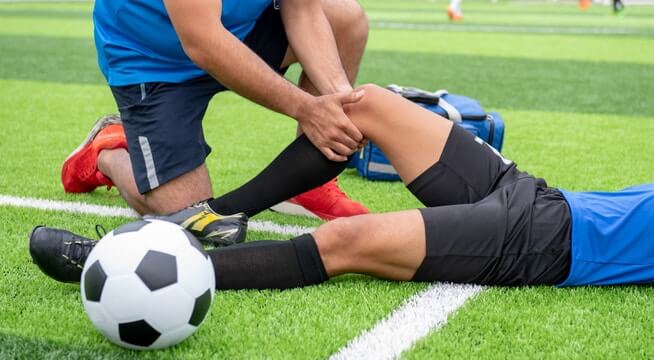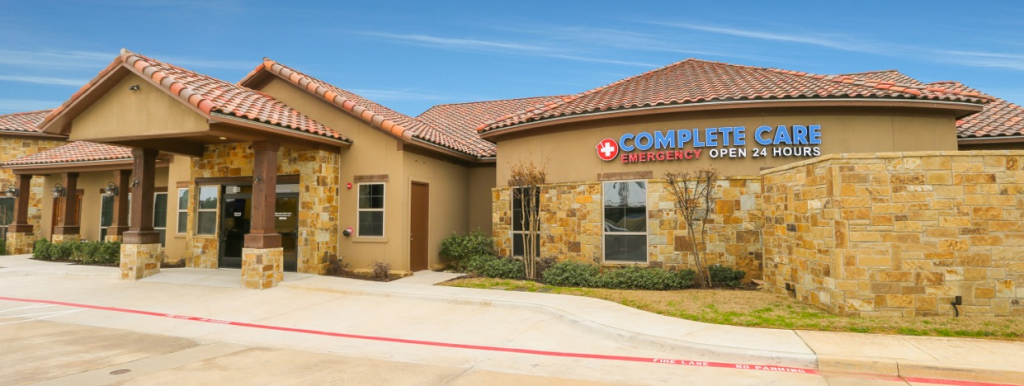
Playing sports is fun and it provides many benefits: discipline, sportsmanship, camaraderie, good health, endorphins, and seeing firsthand how the effort you put in yields results on the field, court, swimming pool, or race course.
That being said, being an athlete comes with the reality of a higher than average risk of injury. This doesn’t mean that you should shy away from sports, it’s simply an announcement to wear appropriate gear and consult a coach on form and how to safely increase your level of activity. This will help you minimize the likelihood of being injured. Note that we wrote minimize; not eliminate. Below is a list of the most common sports injuries and their treatment options. Learn how to recognize symptoms and the importance of taking a break when your body needs it.
The 7 Most Common Sports Injuries & How to Treat Them
1. Concussion
Concussions are traumatic brain injuries that occur when a fall or hard hit causes the brain to move forward and back in a rapid motion. Sometimes, the hit is so severe, the person loses consciousness. However, there are many instances when a person has suffered a concussion and is not aware of it. This is why it’s essential to recognize symptoms: headache, blurred vision, dizziness, sensitivity to light or noise, ringing in the ears, nausea, and confusion, among others.
Treatment: When a person is diagnosed with a concussion, they have to be monitored for 24 to 48 hours for any behavioral changes, slurred speech, or worsening of symptoms. The patient will also have to take both physical and mental breaks and completely rest for a specific timeframe as ordered by the rendering physician.
2. Shoulder Dislocation
The shoulder is a ball-and-socket joint. When playing contact sports, a hard blow to the shoulder may cause the ball portion of the joint to come out of its socket. When this occurs, the patient will feel intense pain, there will be a bump on the back of the shoulder, and the joint will swell.
Treatment: To treat it, a doctor will provide sedatives, then maneuver the ball back into its socket. The shoulder will be immobilized with a sling. The medical provider may prescribe muscle relaxers while the shoulder recovers from the trauma. Before returning to the sport of choice, the patient will likely have physical therapy and stretching exercises recommended by the doctor.
3. ACL or MCL Tear
ACL stands for Anterior Cruciate Ligament, while MCL stands for Medial Collateral Ligament. They both hold the patella (knee cap) in place. The ACL runs diagonally in front of the knee, while the MCL is located on the inner (medial) side of the knee. Injuring either one is extremely painful and will impair mobility. They both result in swelling, tenderness, an inability to fully extend the leg, and a feeling that the knee will “give out”.
Treatment: Conservative treatment may include wearing a compression sleeve, icing the injury for 15 to 20 minutes at a time, and keeping the knee elevated. However, an ACL tear may require surgery (especially when the patient is an athlete who wants to return to the playing field), while an MCL tear may heal on its own.
4. Tennis Elbow
Tennis elbow is the popular term for lateral epicondylitis. Being diagnosed with this condition means that the tendons around the elbows have experienced tears and are inflamed. As a result, the athlete experiences pain on the outside part of the elbow, as well as stiffness, tenderness to the touch, and a burning sensation.
Treatment: Treatment includes icing the elbow for 15 to 20 minutes at a time and wearing an arm brace. This serves two purposes: keeping the elbow elevated and immobilizing it, which are both necessary to fully heal. The patient may apply cortisone cream to reduce pain, and undergo physical therapy when the medical provider deems it appropriate.
5. Achilles Tendon Tear
The Achilles tendon connects the calf muscles to the heel bone. When injured, the patient will experience pain, difficulty walking, swelling, and an inability to stand on the toes. This type of injury occurs when there’s a sudden increase in activity, pushing the body too fast without adequate and gradual training, quickly starting and stopping, and not warming up properly before exercise.
Treatment: If the tear is minor, it’ll heal on its own by simply taking a break from the activity. Over-the-counter ibuprofen should alleviate pain. If the tear is significant, your physician may recommend physical therapy. Surgery is a possibility, yet unlikely and only used as a last resort when conservative treatment doesn’t work.
6. Sprained or Fractured Toe
If your toe is sprained, the injury is to the ligaments around the toe bones. If it’s fractured, a bone is broken. Both types of injury result in pain in the toe. However, a sprain will still allow you to move your toe, while a fracture significantly reduces the range of motion. They both cause throbbing, tenderness, and swelling. If the toe is broken, there will be a burning sensation.
Treatment: Treating both requires taking time to rest from athletic events. Sprained toes can be treated with home remedies, such as icing the injury for 15 to 20 minutes at a time and taking an over-the-counter anti-inflammatory to alleviate pain. Meanwhile, a broken toe will require medical attention to prevent complications such as deformity or bone spurs. You may have to wear a cast and use crutches for several weeks.
7. Stress Fractures
Sometimes, a sports injury is not due to a hard fall or hit, but a result of repetitive movement over an extended period of time. Stress fractures are hairline cracks that occur in the bones of the foot. When a person is suffering from this type of injury, they’ll feel pain while doing physical activity; the pain subsides during rest periods. The affected area also feels tender and warm to the touch. Stress fractures can be prevented by wearing adequate shoes for the sport of choice, doing dynamic drills before exercising, and increasing the intensity of workouts in a very gradual manner, to allow the body to get used to the additional stress.
Treatment: The only way to heal a stress fracture is to take an extended break from the sport. Yes, it’ll set back your endurance and fitness level, but so will competing with an injury.
24-Hour Emergency Room Services in Colorado Springs and Texas
If you or a loved one have suffered a sports injury, we can provide the care you need. If you have questions or need immediate treatment, your nearest Complete Care location is ready to help, no matter the time of day or night. We offer a variety of services to help you and your family in your time of need. No appointments are necessary.
Find the Complete Care location nearest you.
